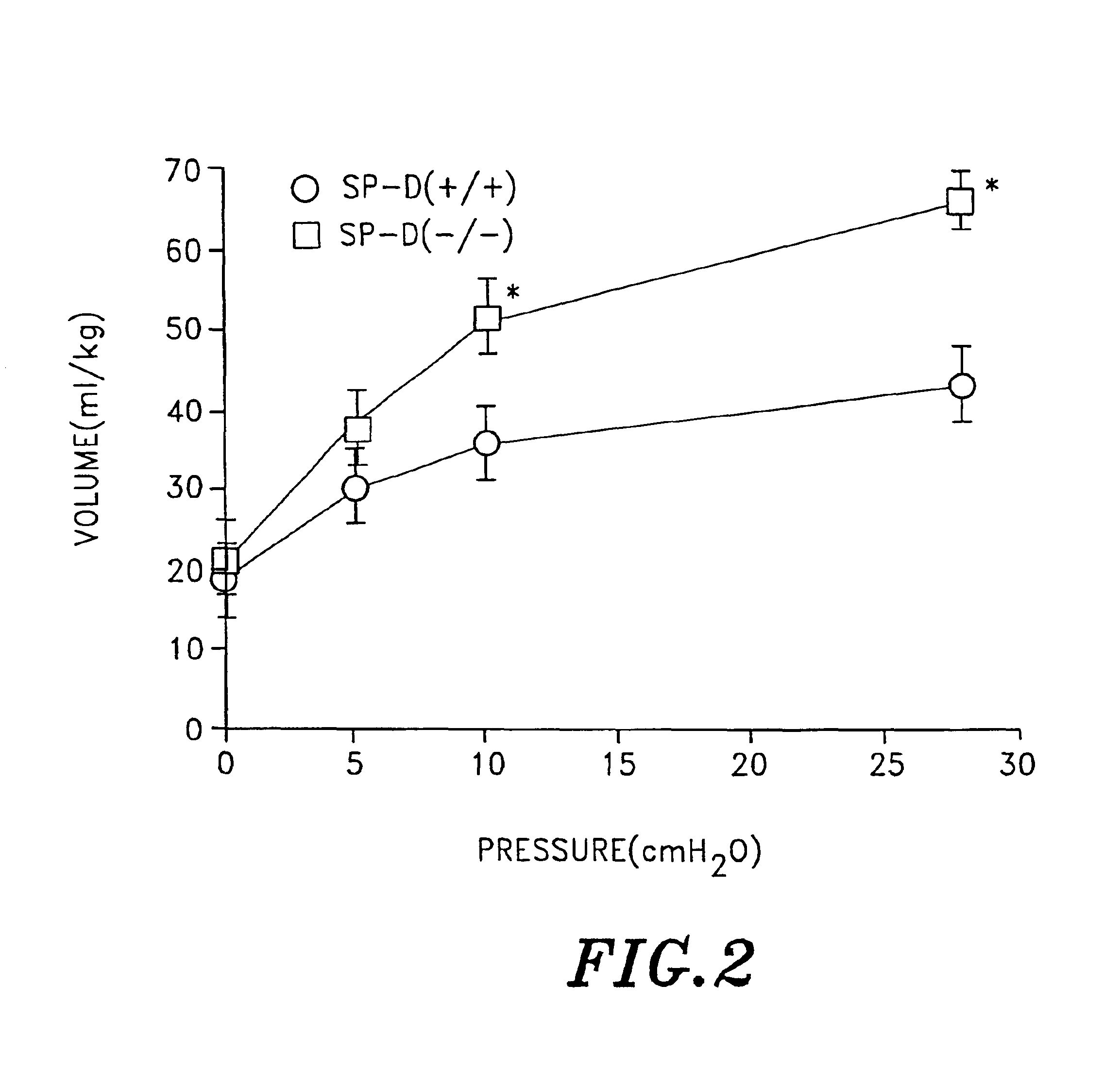Surfactant protein D for the prevention and diagnosis of pulmonary emphysema
a technology of pulmonary emphysema and surfactant protein, which is applied in the direction of peptide/protein ingredients, aerosol delivery, unknown materials, etc., can solve the problems of inability to detect specific deficiencies in sp in vivo
- Summary
- Abstract
- Description
- Claims
- Application Information
AI Technical Summary
Benefits of technology
Problems solved by technology
Method used
Image
Examples
example 1
SP-D (− / −) Knockout Mouse Construction
SP-D (− / −) mice were generated by targeted gene inactivation. Integration of a pGKneo targeting vector containing sequences from exon 2 of the SP-D gene generated a deletion of the second exon of the SP-D gene, which included removal of the initiating methionine and translation initiation sequences. The mouse SP-D gene sequence of Exons 1 and 2 can be found under Genbank accession No. AF047741. The targeting vector was designed using pGKneo by first subcloning a 5.1-kb blunt ended KpnI-tailed HindIII genomic fragment encoding intron 2 through exon 6 into a KpnI site between the neomycin-resistance cassette and the thymidine kinase cassette. Subsequently, a 1.5-kb genomic PstI fragment containing a portion of intron I was tailed with Xhol linkers and cloned into an Xhol site 5′ from the neomycin-resistance cassette Eight of 104 ES clones surviving the double selection process were correctly targeted as determined by both 5′ and 3′ PCR analyses. C...
example 2
Phospholipid Levels in the SP-D (− / −) Mouse
Alveolar, tissue and total saturated phosphatidylcholine (Sat-PC) (p<0.001) was increased about 3-fold in SP-D (− / −) mice. Levels of Sat-PC were not altered in SP-D (+ / −) mice. For alveolar lavage phospholipid composition analysis, two to four samples consisting of the pooled lavage from two to three mice were evaluated for the relative abundance of phosphatidylcholine, phosphatidylethanolamine, phosphatidylglycerol, phosphatidylinositol, sphingomyelin, and lyso-bis-phosphatidic acid. Phospholipid composition did not differ among genotypes. Incorporation of (3H)choline into total lung Sat-PC was slightly increased 8 hr following injection, incorporation being approximately 20% greater in SP-D (− / −) mice (p<0.05).
This result was completely unexpected in that previous work suggested a definite role for SP-A and a limited role for SP-D in lung phospholipid homeostasis. Previous diseases associated with surfactant homeostasis involved...
example 3
Reduction in SP-A Levels in the SP-D (− / −) Mouse
No differences in SP-B and SP-C mRNAs or proteins were observed in SP-D (− / −) mice. In contrast, Northern blot hybridization of total lung RNA from SP-D (+ / +), SP-D (+ / −), and SP-D (− / −) mice and hybridization with and SP-A probe showed that SP-A mRNA was reduced in SP-D (− / −) mice. Consistent with the reduction in SP-A mRNA, BAL SP-A protein was apparently reduced by about 25% in SP-D (− / −) mice as assessed by Western blot analysis of alveolar lavage from three mice.
Therefore, SP-D has a role in the regulation of SP-A production. Since SP-A is involved in host defense in the lungs, SP-D can affect host defense in two ways. By up-regulation of SP-A production and by direct interaction with immune and microbial cells.
The ultrastructure of the phospholipid rich material isolated form the BAL of the SP-D (− / −) mice was evaluated as explained in example 4.
PUM
| Property | Measurement | Unit |
|---|---|---|
| length | aaaaa | aaaaa |
| pH | aaaaa | aaaaa |
| pH | aaaaa | aaaaa |
Abstract
Description
Claims
Application Information
 Login to View More
Login to View More - R&D
- Intellectual Property
- Life Sciences
- Materials
- Tech Scout
- Unparalleled Data Quality
- Higher Quality Content
- 60% Fewer Hallucinations
Browse by: Latest US Patents, China's latest patents, Technical Efficacy Thesaurus, Application Domain, Technology Topic, Popular Technical Reports.
© 2025 PatSnap. All rights reserved.Legal|Privacy policy|Modern Slavery Act Transparency Statement|Sitemap|About US| Contact US: help@patsnap.com



